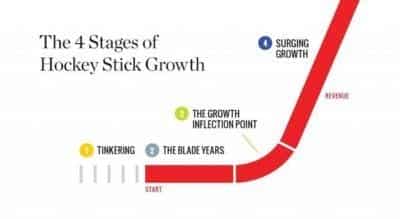What is Hypergrowth?

What is hypergrowth? There have been few buzzwords in tech over the last ten years quite as prolific as “growth”. It’s no surprise then, that one of the most talked-about concepts over the last few years is a spin on that.
Hypergrowth.
Far from a buzzword, however, hypergrowth represents a concrete, well-defined stage in a company’s growth cycle. A dizzying, uncontrollable flurry of expansion, hypergrowth almost always ends with a single untenable fact: that company is on the fast track to becoming a unicorn.
So how exactly do we define hypergrowth?
Hypergrowth really is a concrete thing – in fact, you can see it.
You’ve probably heard of hockey-stick curves. It’s the growth inflection every company strives for – a single point where the stars align and you see a dramatic uptick in your growth rate. This is what a hockey-stick curve looks like, and top-tier companies experience more than a few of these:

The second part of the curve is hypergrowth. It’s a wild ride – an ofter overnight, dramatic change in your company’s trajectory, where your servers start failing, your customer support starts working weekends and your CEO starts to grow bald.
It’s the holy grail of the modern startup – a point of growth so dramatic its signaling you’ve made it. You’re in the big leagues – you’ve convincingly proven product-market fit, and you’re ready to shoot for the upper echelons of your market.
Slack’s Meteoric Rise
Probably the finest example of hypergrowth in the industry over the last decade has been Slack.
A company that started off as a kichy video game experiment gone wrong, the business productivity/web-chat tool has exploded – going from release to IPO in less than 6 years flat. Their hypergrowth point?
In the year 2014, Slack grew from 16,000 users to over 285,000 users – an increase of nearly 1700%. Over 2015, it grew that 285,000 users to a whopping 1 million – a growth rate of 250%. They doubled again the next year, hitting a $4b valuation and breezing past any semblance of competition left in the market.
Slack had 3 straight years of a minimum 100% growth and experienced something you only see a few times every decade – a company that hits hypergrowth almost immediately after launch.
Slack never had a long lead up – it’s inflection point hit happened a few months after launching, and it never stopped.
Zapier – the steadier hypergrowth
Hypergrowth comes in many different packages. For all of Slack’s meteoric rise, there is a catch – over their 6 years pre-IPO, Slack raised over a billion dollars of funding to help fuel its growth.
Venture, however, isn’t the only path to hypergrowth (and, in fact, often leads to an “illusion” of hypergrowth if your acquisition costs aren’t profitable)
Perhaps the best example of hypergorwth over a similar time scale of Slack without the whopping resources behind it is Zapier, the automation company famous for 2 things: 1) being fully remote, and 2) never raising anything beyond their initial $1M seed round.
Despite very limited fundraising, Zapier grew to a steady $20M In annual revenue by the beginning of 2017 over a period of about 5 years. As they rounded in the year 2017, hypergrowth began – Zapier more than doubled their annual revenue over the next 20 months, closing out 2018 with well over $50M in annual revenues.
And again: this is without a dime of funding.
So, how does hypergrowth happen?
Hypergrowth is a moment of stars aligning. In Slack’s case, it was timing – there was a tentative gap in the market is very precariously filled by combinations of a broken hipchat and email, and Slack’s simplicity and UI came in and seized the day.
Zapier’s was a bit slower – they were coming into a market with a big, well-funded incumbent (IFTT). It took them a few years to break ground, integrating with enough tools to slowly grow market share. The real inflection point came in late 2016 when they released a fully self-serve development platform and crossed the 1000 app mark – at that point, there was no looking back.
Hypergrowth is the ultimate expression of product-market fit – when your product, acquisition strategies, and market environment all synergize in a single, beautiful moment of dramatic, shattering growth that defines a company.
Put those insights into practice.
Set your team up for success by improving their performance through gamification.
Back to blog







